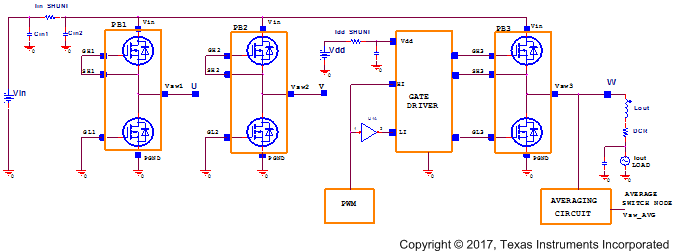SLPS597D April 2017 – June 2024 CSD88599Q5DC
PRODUCTION DATA
- 1
- 1Features
- 2Applications
- 3Description
- 4Specifications
-
5Application and Implementation
- 5.1 Application Information
- 5.2 Brushless DC Motor With Trapezoidal Control
- 5.3 Power Loss Curves
- 5.4 Safe Operating Area (SOA) Curve
- 5.5 Normalized Power Loss Curves
- 5.6 Design Example – Regulate Current to Maintain Safe Operation
- 5.7 Design Example – Regulate Board and Case Temperature to Maintain Safe Operation
- 5.8 Layout
- 6Device and Documentation Support
- 7Revision History
- 8Mechanical, Packaging, and Orderable Information
Package Options
Mechanical Data (Package|Pins)
- DMM|22
Thermal pad, mechanical data (Package|Pins)
5.3 Power Loss Curves
CSD88599Q5DC was designed to operate up to 10-cell Li-Ion battery voltage applications ranging from 30V to 42V, typical 36V. For 11 and 12s, input voltages between 42V to 54V, RC snubbers are required for each switch-node U, V, and W. To reduce ringing, refer to the Section 5.8.1.1 section. In an effort to simplify the design process, Texas Instruments has provided measured power loss performance curves over a variety of typical conditions.
Figure 4-1 plots the CSD88599Q5DC power loss as a function of load current. The measured power loss includes both input conversion loss and gate drive loss.
Equation 1 is used to generate the power loss curve:
The power loss measurements were made on the circuit shown in Figure 5-3. Power block devices for legs U and V, PB1 and PB2 were disabled by shorting the CSD88599Q5DC high-side and low-side FETs' gate-to-source terminals. Current shunt Iin_SHUNT provides input current and Idd_SHUNT provides driver supply current measurements. The winding current is measured from the DC load. An averaging circuit provides switch node W equivalent RMS voltage.
 Figure 5-3 Power Loss Test Circuit
Figure 5-3 Power Loss Test CircuitThe RMS current on the CSD88599Q5DC device depends on the motor winding current. For trapezoidal control, the MOSFET RMS current is calculated using Equation 2.
Taking into consideration system tolerances with the current measurement scheme, the inverter design needs to withstand a 20% overload current.
| Winding RMS Current (A) | CSD88599Q5DC IRMS (A) | Overload 20% × IRMS (A) |
|---|---|---|
| 20 | 28 | 34 |
| 30 | 42 | 51 |
| 40 | 56 | 68 |